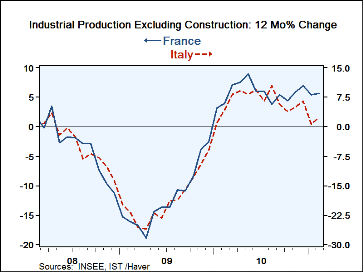 Global| Apr 11 2011
Global| Apr 11 2011French and Italian IP Continue to Expand But Italy Shows Momentum Loss
Summary
France and Italy continue to see their industrial production expand. France is showing more staying power as Italy show signs of slippage in its growth. This is their first real divergence in this cycle. France is showing persistent [...]
 France and Italy continue to see their industrial production expand. France is showing more staying power as Italy show signs
of slippage in its growth. This is their first real divergence in this cycle.
France and Italy continue to see their industrial production expand. France is showing more staying power as Italy show signs
of slippage in its growth. This is their first real divergence in this cycle.
France is showing persistent lethargy in consumer nondurables; but balanced by strength in consumer durables. For Italy it is the capital goods sector that is weak even though that sector seems strong in several other EMU nations, including France.
France is showing real strength in capital goods in the current quarter- a double digits growth rate- whereas for Italy the quarter-to-date reading points to a decline in output in that sector.
The consumer sector which had been a negative for output in Italy has come back into positive territory in the last three months. France is experiencing differing trends for durable and nondurable consumer goods. Transportation output that has been declining over three- and six-months in Italy is strong over those horizons in France. France also shows strength in intermediate goods while Italy is showing a more moderate performance.
Consumer goods output is weak in current quarter for both Italy and France but France still shows the stronger growth rate while for Italy the consumer sector has started to revive slightly despite its still-low rate of growth.
For Italy there was both good and bad news over the weekend. As a nation with a high debt load, news that Greece may require more funding cannot be a settling development. But the hint that Libya could be headed for a cease fire could be good news as Italy and Libya are linked economies.
For France its involvement in the Ivory Coast is deepening. Meanwhile, in Libya, although Gaddafi shows signs of accepting the cease fire there are concerns that he may be playing for time and has no intention of leaving office. With such flux in the Middle East he may feel that he can hang on as the US gets preoccupied with budget issues, France gets distracted in the Ivory Coast the rest of the Middle East continues to show festering problems and as the UN alliance begins to show more cracks. The cease fire proposed for Libya may seem to be good news but in reality it is too soon to tell what opportunities it may portend.
France remains stronger than Italy on all counts: its year-to-year growth is stronger; its sequential growth rates are consistently more positive, and France is much stronger in the quarter-to-date readings. Geopolitics will continue to be issues for these countries but for now they seem to be on slightly different economic paths or the first time in this cycle.
| French IP Excluding Construction | |||||||
|---|---|---|---|---|---|---|---|
| SAAR Except M/M | Feb'11 | Jan'11 | Dec'10 | 3Mo | 6Mo | 12Mo | Qtr-to-Date |
| IP total | 0.4% | 0.7% | 0.3% | 6.1% | 6.6% | 5.6% | 9.8% |
| Consumer Dur | -0.7% | 0.6% | 1.5% | 5.5% | -15.3% | 4.6% | 3.2% |
| Consumer Ndur | -0.1% | 0.8% | -0.3% | 1.5% | 1.5% | 1.5% | 2.9% |
| Capital | 1.9% | -0.1% | 1.3% | 13.2% | 9.7% | 10.4% | 11.4% |
| Intermed | 0.1% | 4.1% | -1.5% | 10.9% | 11.1% | 8.8% | 19.8% |
| Memo | |||||||
| Auto | 1.3% | 3.1% | 1.6% | 26.8% | 35.8% | 12.8% | 49.8% |
| Italy IP Excluding Construction | |||||||
| SAAR Except M/M | Feb'11 | Jan'11 | Dec'10 | 3Mo | 6Mo | 12Mo | Qtr-to-Date |
| IP-MFG | 1.2% | -1.3% | 0.2% | 0.4% | -3.1% | 3.1% | 1.5% |
| Consumer | 1.5% | -2.2% | 1.3% | 2.1% | -3.1% | -1.2% | 1.7% |
| Capital | 0.8% | -0.1% | -1.6% | -3.8% | -8.0% | 7.1% | -1.3% |
| Intermed | 0.5% | -0.7% | 1.0% | 3.0% | 0.2% | 4.1% | 5.9% |
| Memo | |||||||
| Transportation | 1.3% | 1.1% | -2.4% | -0.4% | -7.3% | 3.4% | 8.0% |
Robert Brusca
AuthorMore in Author Profile »Robert A. Brusca is Chief Economist of Fact and Opinion Economics, a consulting firm he founded in Manhattan. He has been an economist on Wall Street for over 25 years. He has visited central banking and large institutional clients in over 30 countries in his career as an economist. Mr. Brusca was a Divisional Research Chief at the Federal Reserve Bank of NY (Chief of the International Financial markets Division), a Fed Watcher at Irving Trust and Chief Economist at Nikko Securities International. He is widely quoted and appears in various media. Mr. Brusca holds an MA and Ph.D. in economics from Michigan State University and a BA in Economics from the University of Michigan. His research pursues his strong interests in non aligned policy economics as well as international economics. FAO Economics’ research targets investors to assist them in making better investment decisions in stocks, bonds and in a variety of international assets. The company does not manage money and has no conflicts in giving economic advice.






